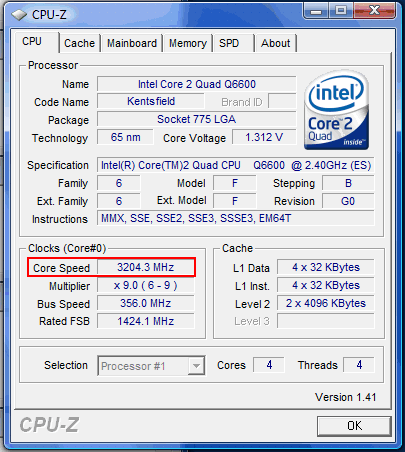Overclocking: Dual- vs. Quad-Core CPUs
Overclocking II - Quad-Core Q6600 At 3.20 GHz
We continue to push for higher clock speeds. Next, the processor hit the 3.20 GHz mark, albeit at a much higher core voltage than its dual-core counterpart. To reach this frequency, we had to increase the voltage by a full 0.100 V to enable it to complete the Prime95 test without issue on a front-side bus of 356 MHz (1424 QDR).
Q6600 at 3.20 GHz
Along with the clock speed, the memory frequency increases to DDR2-854 (427 MHz), while still running at a latency of CL 4.0-4-4-12. That such a dramatically increased core voltage is needed to achieve this speed is due to the Q6600's design, which uses two dual-core chips. Here, the probability that one of the two cores has lower overclocking potential is twice as high, even though both of the dual-core parts inside use the G0 stepping. Also, two dual-cores dissipate twice as much heat, which in return results in a higher CPU temperature, leading to a higher risk of instability.
DDR2-854 is child's play for our GEIL memory
Still smooth sailing in Prime95 at 3.20 GHz
| Core 2 Quad Q6600 @3.20 GHz | |
|---|---|
| CPU Frequency | 3.20 GHz (+33.3%) |
| FSB | 356 MHz (1424 QDR) |
| Core Voltage | 1,4125 Volt |
| Memory Multiplier | 2.40x |
| Memory Frequency | DDR2-854 (427 MHz) |
| Memory Latency | CL 4.0-4-4-12 |
Current page: Overclocking II - Quad-Core Q6600 At 3.20 GHz
Prev Page Overclocking I - Quad-Core Q6600 At 3.00 GHz Next Page Overclocking III - Quad-Core Q6600 At 3.30 GHzGet Tom's Hardware's best news and in-depth reviews, straight to your inbox.
Tom's Hardware is the leading destination for hardcore computer enthusiasts. We cover everything from processors to 3D printers, single-board computers, SSDs and high-end gaming rigs, empowering readers to make the most of the tech they love, keep up on the latest developments and buy the right gear. Our staff has more than 100 years of combined experience covering news, solving tech problems and reviewing components and systems.



